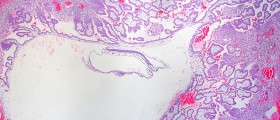
Tracheostomy is a medical procedure during which a doctor makes an incision in the front part of the neck and creates an opening in the trachea. This is actually one of the oldest surgical procedures. The hole (stoma) created in such a way serves perfectly as an airway. What is more a tracheostomy tube may be easily inserted at the site of incision and it prevents its closure. The procedure is highly efficient in all individuals who are suffering from conditions interfering with normal flow of air through the nose and mouth. It is also a life saving procedure when performed in people who experience a sudden obstruction in the upper parts of the respiratory tract.
What is Tracheostomy Tube?
A tracheostomy tube is a relatively small tube that is inserted in the hole created by a surgeon. The tube is inserted directly into the trachea and this way it allows air to enter directly into the lungs without having to pass through practically all the parts of the upper respiratory tract.
There are several sizes of tracheostomy tube. The tube may also be made of different materials. The most frequently used tracheostomy tubes have three parts, the outer cannula with flange (in charge of holding the tracheostomy open), inner cannula (a part that is inside the outer cannula) and obturator. The obturator is essential for insertion of the tube. The inner cannula plays an important role in preventing coughing up the tube and is also used for cleaning the entire system.
There is a variety of tracheostomy tubes and they should be chosen according to patient's needs, the time of the year and several more factors. Prior to choosing the tube it is best if a health care provider first consults with specialist practitioners and manufacturers.
The tube may have a cuff or is without it. Cuffed tubes are reserved for patients with swallowing difficulties as well as those who require mechanical ventilation while the tubes without a cuff are used in less severe forms of breathing difficulties and patients who can swallow without any additional problems.
Why is Tracheostomy Performed?
The goal of tracheostomy is to provide with sufficient amount of air to the lungs. So, in case an individual cannot breathe without help, has problems due to excess of mucus or other secretions that fill the windpipe or has experienced sudden obstruction of the upper respiratory tract, he/she inevitably undergoes tracheostomy.
Doctors differentiate emergency tracheostomy and surgical tracheostomy. Emergency tracheostomy is performed only in case of emergency situations when the goal is to allow patients to breathe within short period of time because they are vitally jeopardized. The procedure of this type is performed in the emergency room by a physician or a surgeon who makes a cut in the larynx, to be more precise in the cricothyroid membrane. What follows is insertion of a tube which is then connected to an oxygen bag. The other type of tracheostomy called surgical tracheostomy requires more time and is usually performed in an operating room. During the procedure the surgeon first makes a cut in the skin between the Adam's apple and the proximal part of the breast bone. He/she then separates the muscles of the anterior part of the neck, reaches the rings cartilage of the trachea and cuts through the organ's front wall. Finally a metal, plastic tracheotomy tube is inserted through the surgically created hole. The hole is made in such a way that it allows connection with mechanical ventilator if this is necessary. After surgical tracheostomy patients remain hospitalized for 3-5 days. The recovery takes approximately a couple of weeks.
Now, when it comes to reasons why air simply cannot get to the lungs, they vary a lot. For instance, the trachea may be blocked due to swelling of the lining of the organ. Furthermore, one may suffer a severe injury to the neck, nose or mouth which leads to massive bleeding, crush injuries of various tissues all of which may cause airflow obstruction. Accidental aspiration of a large foreign object may also be a serious medical issue that requires emergency tracheostomy. The procedure is also necessary in patients suffering from paralysis of the throat muscles and those in whom airflow is jeopardized by the presence of a tumor. Finally, patients in coma or those who require a mechanical ventilator are the ones that usually need to undergo tracheotomy.
After tracheostomy patients communicate with others by writing. They need some time to adopt additional communication techniques. The outer cannula is never supposed to be removed prior to consulting a health care provider. It is also important to cover the tracheostomy with specific tracheostomy covers which prevent dust particles and cold air from entering the airway.
Finally, it is normal to experience some pain and discomfort for a week after the procedure. Now, if pain persists, one has breathing difficulties or irregular heart beat, he/she is due to seek medical attention immediately.


-And-Breathing-Problems_f_280x120.jpg)














Your thoughts on this
Loading...